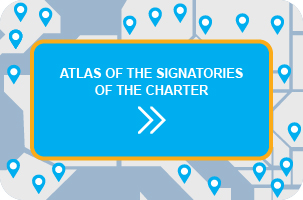Swedish Association of Local Authorities and Regions celebrates the 10th anniversary of the European Charter for Equality
[by Anna Ulveson, Senior Adviser and Gender Equality Expert at SALAR]
Celebration
On the 6th of September, the Swedish Association of Local Authorities and Regions (SALAR) organised a party to celebrate 10 years of working with the European Charter for Equality of Women and Men in Local Life.
The festivities started with a speech from Håkan Sörman, the President of SALAR. He told the story about when he was in Innsbruck in 2006 when the Charter was approved. It was a rainy day in May. He didn’t think much about the Charter; he thought it would become something that would be left to gather dust in a bookshelf somewhere. He admits now that he was very wrong and the Charter developed into something much bigger and impactful than he had anticipated.
The board of SALAR was one of the first to sign the Charter. It then sent a letter to all Swedish municipalities, county councils and regions and urged them to sign and implement the Charter as well. Quite an unusual for the board to do! However, it proved effective, Sweden now has 117 signatories.
Next, Heléne Fritzon, Vice President of the CEMR Standing Committee for Equality, spoke about the importance of a political commitment for gender equality. It’s simply not enough to just sign the charter; there must be an action plan and politicians who ask for monitoring and results. “Hold on and hold out!”, she said. “Don’t give up! Municipalities, county councils and regions have an important role for advancing gender equality, not only as large employers but also for the society as a whole. The services that we provide are a prerequisite for women and men, girls and boys to live gender equal lives.” There is also a need for skilled people who know how to mainstream gender and who can help and support managers and employees. Without training and technical expertise, actions will have limited impact and sustainability!” Heléne Fritzon also spoke of the importance of the Observatory and the support that SALAR was able to give in getting it up and running. She stressed the significance of cooperation and exchange of experiences in Europe.
Frèdèric Vallier, Secretary General of CEMR, sent a video greeting and message of encouragement for the celebration, much appreciated by the SALAR team. “It made us feel closer to our friends in in Europe and the bigger picture of people working for gender equality.”
Following the video message, Helén Lundkvist Nymansson, Head of the gender equality section at SALAR, spoke about the Charter, the Swedish gender equality policy and other international conventions such as the Beijing platform for action. She stressed that the Charter is an important part of this framework. It is the only gender equality Charter for local and regional levels (for now) and it’s on those levels that change for gender equality will be made in practice.
Then the SALAR team shared hot coffee and a large cake featuring the map of all of CEMR’s member states.
Lena Sturk, from the municipality of Piteå, shared her experience of working with the Charter and integrating gender equality in their management and steering processes. “In Piteå, we do it our own way”, she said. “We have signed the Charter but we don’t have an action plan. Instead, there are local action plans and in the Annual Report you can read how we’ve developed and you also can see that we’ve worked with almost all the articles of the Charter. Additionally, nearly all statistics based on individuals are now disaggregated by sex.”
New comparative study released
Finally, Magnus Jacobson, Senior Adviser and gender equality expert, presented the ranking of women and men of all of SALAR’s members, called Open Comparisons. The ranking was developed based on 23 key indicators from politics, working life and services, most of them gathered from SALAR’s ordinary statistical systems.
Usually, gender gap indices measure the outcome for women in relation to outcome for men, e.g. women’s median income as a percentage of men’s median income. This way of measuring inequalities has a few setbacks. For one: any relation where the outcome for women is larger than the outcome for men, it will be rendered invisible, since anything exceeding women’s share of men’s outcome exceeding 100 percent will be deemed gender neutral. Furthermore, consistently measuring women against men only serves to enforce the notion of the male norm, making women the exception.
Instead, SALAR has developed a new kind of measurement, where the comparison between municipalities and regions is based on quotients, expressing the ratio between outcomes for women and men, and where the digit 1 expresses total gender equality in outcome. An example: If average sick leave measured as share of total annual working time for employees in municipality A is 6,2 per cent for women and 2,5 per cent for men, the quotient then is 6,2/2,5=2,48. In municipality B, women’s sick leave amounts to 4,5 per cent, and men’s to 3,6 percent, giving the quotient 1,25, thus giving municipality B a higher ranking than municipality A.
With municipality C, however, we face another challenge since women have actually shorter sick leave (2,8 per cent) than men (3,6 per cent), which gives us a quotient lower than 1, that is 2,8/3,6=0,78. This is a problem, since quotients below 1 can’t be compared to quotients over 1. The solution for us has been to use either the quotient from women/men or from men/women, choosing the one quotient that is 1 or above for each and every municipality. This way, we can stick to the original idea of ranking municipalities in relation to 1. To keep track of whether women or men are at a disadvantage we mark the quotients: light blue where women have the highest outcome and dark blue where men have the highest outcome, giving us charts where structural gender inequalities are made visible.
This way of using quotients instead of shares allows us to compare gender differences on the same scale, irrespective of if women or men are at a disadvantage.
The SALAR Open Comparisons study is available in Swedish at: http://webbutik.skl.se/sv/artiklar/oj-jamstalldhet.html

Heléne Fritzon, Member of SALAR Board of Directors and Vice-President of CEMR Standing Committee for Equality, cuts the cake

















